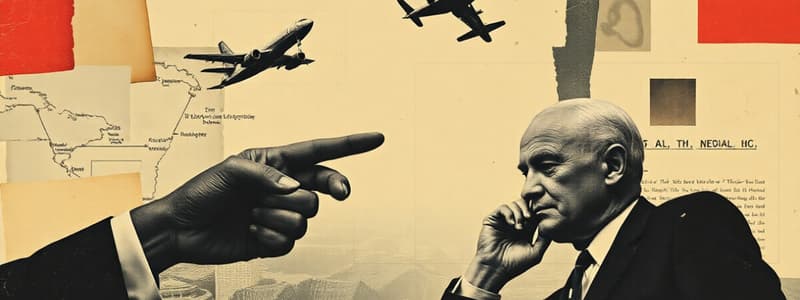Podcast
Questions and Answers
Which scenario best exemplifies 'crisis bargaining' in global politics?
Which scenario best exemplifies 'crisis bargaining' in global politics?
- An international organization imposing economic sanctions on a country violating human rights.
- Negotiations between two nations during a tense standoff where both sides threaten escalation. (correct)
- A country increasing its military spending to deter potential aggressors.
- A nation launching a preemptive strike against an imminent threat.
How does the concept of 'indivisibility of resources' typically contribute to the likelihood of war?
How does the concept of 'indivisibility of resources' typically contribute to the likelihood of war?
- It creates a situation where compromise is difficult, as neither party is willing to share control. (correct)
- It encourages states to seek diplomatic solutions to resource allocation.
- It decreases the strategic value of resources, leading to less conflict.
- It promotes cooperation as states recognize the mutual benefits of shared resource management.
What is the most accurate description of how states 'pay for power' in the international system?
What is the most accurate description of how states 'pay for power' in the international system?
- By devaluing their currency to make exports more competitive.
- By forming alliances with powerful nations to gain protection.
- By directly purchasing territories from weaker states.
- By spending resources (military, diplomatic, economic) to increase global influence. (correct)
Why is the credibility of a threat essential in international relations?
Why is the credibility of a threat essential in international relations?
Which factor most significantly complicates the assessment of a state's 'resolve' in a crisis?
Which factor most significantly complicates the assessment of a state's 'resolve' in a crisis?
How did the system of alliances in pre-World War I Europe contribute to the outbreak of the war?
How did the system of alliances in pre-World War I Europe contribute to the outbreak of the war?
What was the strategic significance of the Kargil War (1999) between India and Pakistan, considering the geographical landscape?
What was the strategic significance of the Kargil War (1999) between India and Pakistan, considering the geographical landscape?
In what way can military force be used as a tool of statecraft, beyond direct warfare?
In what way can military force be used as a tool of statecraft, beyond direct warfare?
How do 'audience costs' affect a leader's decision-making in international relations?
How do 'audience costs' affect a leader's decision-making in international relations?
What role does economic strength play in shaping a state's influence in global politics?
What role does economic strength play in shaping a state's influence in global politics?
Flashcards
Crisis Bargaining
Crisis Bargaining
Negotiating during a crisis where states might escalate or de-escalate conflict.
Prevention (in war)
Prevention (in war)
Acting to avoid a potential future threat, even if it hasn't happened yet.
Preemption (in war)
Preemption (in war)
Striking first based on the belief that the enemy will soon attack.
Indivisibility of Resources and War
Indivisibility of Resources and War
Signup and view all the flashcards
Paying for Power
Paying for Power
Signup and view all the flashcards
Credible Threats
Credible Threats
Signup and view all the flashcards
Resolve in Crisis
Resolve in Crisis
Signup and view all the flashcards
Nuclear Weapons and the Cold War
Nuclear Weapons and the Cold War
Signup and view all the flashcards
United Nations (UN)
United Nations (UN)
Signup and view all the flashcards
NATO (North Atlantic Treaty Organization)
NATO (North Atlantic Treaty Organization)
Signup and view all the flashcards
Study Notes
Key Concepts in Global Politics
- Crisis bargaining involves negotiation during a crisis, potentially escalating or de-escalating conflict through strategic threats, deals, or compromises; an example is the Cuban Missile Crisis.
- Prevention in war is acting to avoid a potential future threat, illustrated by Germany in WWI feeling encircled.
- Preemption in war is striking first based on the belief that the enemy will soon attack, such as Israel's strikes in the Six-Day War.
- Indivisibility of resources and war occurs when a resource (like land or oil) is considered unable to be split, leading parties to war over its control; the Arab-Israeli conflict over Jerusalem exemplifies this.
- "Paying for power" involves states incurring military or diplomatic costs to expand their influence and global position, exemplified by the U.S. entry into WWI.
- Credible threats deter adversaries from unwanted actions when the opposing party believes the threat will be carried out if not heeded, as seen in the U.S. threat to the Soviet Union during the Cuban Missile Crisis.
- Resolve in crisis is the willingness of a state to bear the costs of war, and it is often hard to gauge, leading to miscalculations in international conflicts; in WWII, both the U.S. and USSR persisted in battles like Vietnam and Korea.
World War I
- WWI began after the assassination of Archduke Franz Ferdinand of Austria-Hungary.
- The major alliances included the Triple Entente (France, Russia, Britain) and the Triple Alliance (Germany, Austria-Hungary, Italy).
- Key factors relating to WWI: Nationalism, imperialism, militarism, and the system of alliances.
- Germany's surrender and the Treaty of Versailles led to the U.S. emerging as a dominant global power.
World War II
- Triggered by the invasion of Poland by Germany in 1939.
- The Axis Powers were Germany, Italy, Japan, and the Allied Powers were the United States, United Kingdom, Soviet Union, and France, among others.
- WWII ended with the surrender of Germany and Japan in May and September 1945, respectively.
- Major impacts: Shifts in global power, the Cold War begins, the creation of the United Nations.
Nuclear Weapons and the Cold War
- The U.S. and USSR developed nuclear weapons, emphasizing Mutually Assured Destruction (MAD).
- The Cuban Missile Crisis was the closest the world came to nuclear war.
United Nations (UN)
- Founded after WWII to promote peace and cooperation among states.
- Includes the Security Council (with 5 permanent members: U.S., Russia, China, France, UK).
- Peacekeeping missions often face limitations because of political divisions or insufficient military resources.
NATO (North Atlantic Treaty Organization)
- Formed in 1949 between the U.S., Canada, and Western European countries, NATO's function was to counter the Soviet threat during the Cold War.
- Article 5 of NATO's treaty states that an attack on one member is an attack on all.
System of Alliances in Pre-WWI Europe
- The Triple Entente (France, Russia, Britain) opposed the Triple Alliance (Germany, Austria-Hungary, Italy).
- These alliances created a delicate balance that, once disrupted, led to WWI.
Kargil War (1999)
- It was a conflict between India and Pakistan over the disputed Kargil region.
- Pakistan infiltrated high-altitude posts in Indian territory, followed by India responding with military force.
- Military involvement occurred at high altitudes, with significant military operations by both countries.
The Role of Military in Conflicts
- Military can influence global politics by acting as a deterrent, as a tool for statecraft, and sometimes as a means of enforcing political or ideological aims.
- The U.S. military involvement in the Gulf War, Vietnam War, and the NATO-led interventions in the Balkans are examples of military conflict.
Audience Costs
- Political consequences that leaders face when they make promises or threats that they do not fulfill, leading to a loss of credibility or domestic support.
- U.S. involvement examples: Korean and Vietnam Wars, where public opinion was split.
The Role of Economic Power in Global Politics
- Economic strength is critical for a state to project power and influence globally.
- Trade agreements, sanctions, and economic aid can act as tools of influence.
- Example: The U.S. using economic sanctions against Iran and Russia to influence their behavior.
Pax Britannica
- The period of British global dominance, particularly in the 19th century, characterized by relatively peaceful international relations under British naval and economic power.
- Contributed to a stable global economic system via British leadership in global trade and finance.
The United Nations and Crisis Management
- The UN plays a role in mediating conflicts and preventing war through its peacekeeping forces and diplomatic efforts.
- However, its effectiveness is often limited by the political interests of the Security Council's permanent members.
Studying That Suits You
Use AI to generate personalized quizzes and flashcards to suit your learning preferences.




